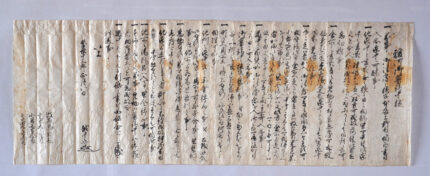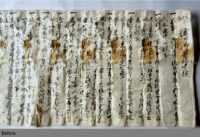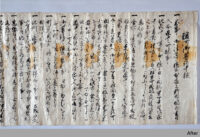Researchers at Kumamoto University have discovered a rare early Edo-period document regulating conduct at an expansive construction project used by the shogun Tokugawa Ieyasu to reel in his fractious lords. Issued by the head of the powerful Hosokawa samurai clan in January of 1608, the document lists 13 articles of behavior to be observed by everyone contracted to work on the reconstruction of Sunpu Castle. Its aim was to prevent conflict from breaking out on the worksite.
A seasoned warrior and daimyo (feudal lord) from a cadet branch of the imperial family, Hosokawa Tadaoki (1563-1646) was the clan leader during the early Edo period. He and the 5,000 troops at his command played a key role at the 1600 Battle of Sekigahara in which Tokugawa Ieyasu consolidated his power and the shogun rewarded Tadaoki for his support with even more lands.
To bring the fractious lords under the control of the newly-established Tokugawa shogunate, Ieyasu initiated major construction projects, in one fell swoop rebuilding castles and defenses damaged during the wars and making the daimyos pay for it, sapping their funds and independence. The code of conduct delegates all authority on the project to superintendent Masazumi Honda, one of the shogun’s top allies and newly-minted daimyo, and four Hosokawa vassals. The next articles ban all fighting within the clan on pain of death, watching a fight between opposing clans, let alone participating in one, or forcing any servants who run away to another house to return until after construction was finished.
The second half of the code provides a glimpse into the life of the soldier class (ashi-garu) mobilized for the project. Alcohol (sake) was strictly prohibited. They could bring their own food (bento), but were not to drink more than three small flat sake cups (sakazuki) of alcohol (Article 6). When going to town, they were supposed to declare the nature of their errand to the magistrate and obtain a permit (Article 7). Meetings with people from other clans or the shogunate were strictly forbidden (Article 8). Hot baths in another clan’s facilities were not allowed (Article 11). Sumo wrestling and spectating were strictly forbidden during the period of the project, and violators would be punished (Article 12). On the round trip between Kokura and Sunpu, workers were to travel in groups as indicated on an attached sheet (Article 13). This purpose of this historical document was to maintain peace at the project site and vividly conveys the aspects of the samurai society during its transition from a time of war to peace and prosperity.
This is the third known document recording behavioral rules during the work on Sunpu Castle. The first was promulgated by Mori Terumoto, lord of the Choshu clan and one of Ieyasu’s former enemies, but contains very similar language. The third is a verbatim copy of the Choshu document created by Maeda Toshinaga, lord of the Kaga clan. Researchers believe the daimyos were going off a sample rule set sent them by the shogun.
The code of conduct was written on two sheers of danshi paper, a thick white mulberry paper first produced in the 8th century that would become the preferred medium for official documents, ceremonial rites and court poetry. The sheets were joined together to make a large, expensive manuscript worthy of the dignity of head of the Hosokawa family. Kumamoto University researchers have conserved the fine paper, repairing a break in the join between the danshi sheets and restored their prized whiteness.


